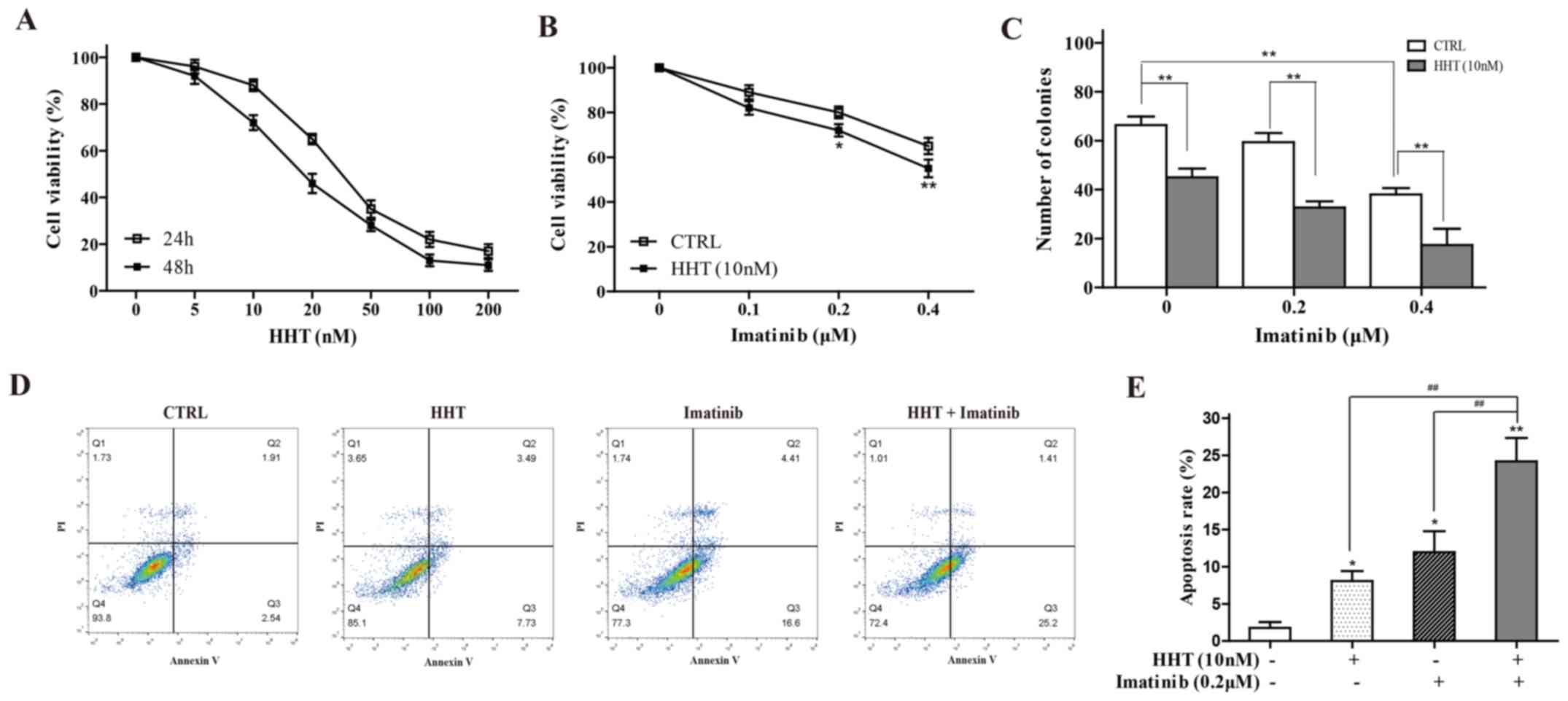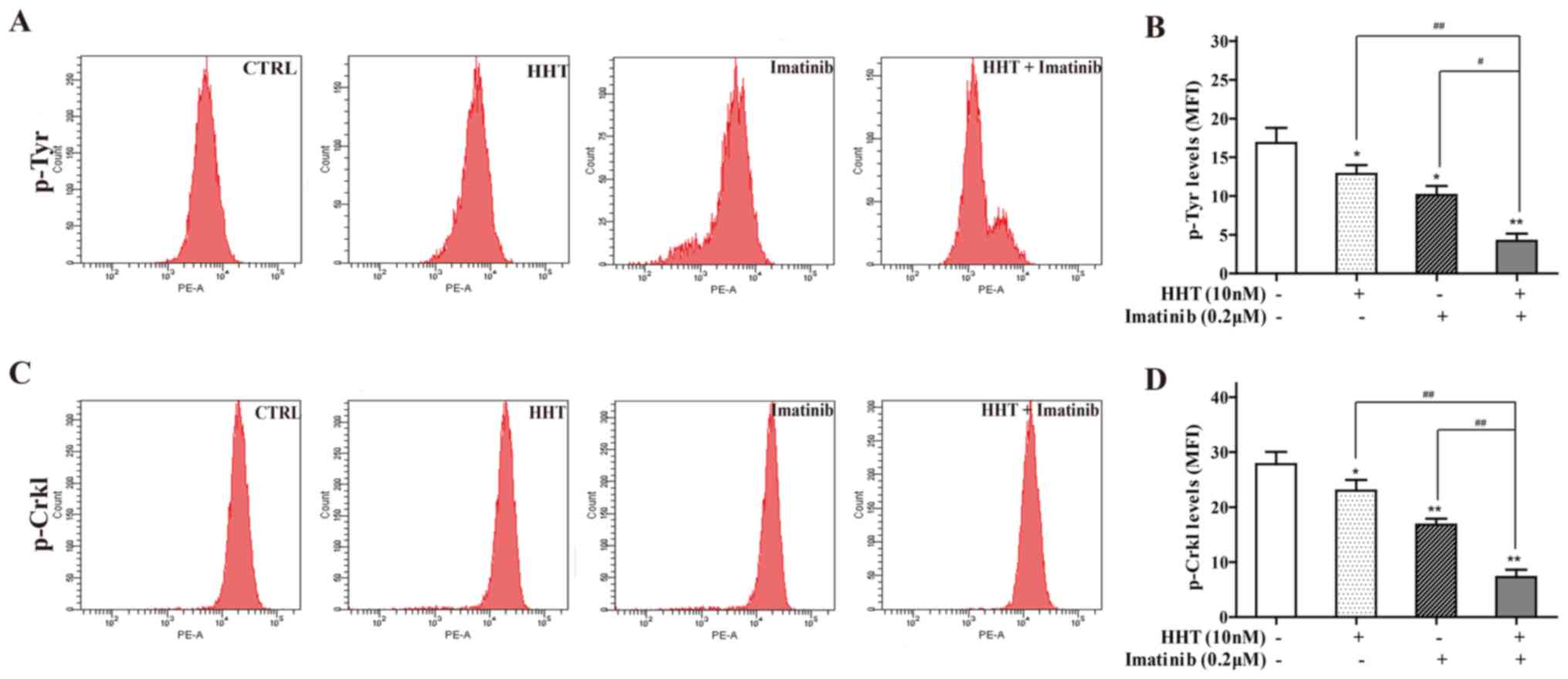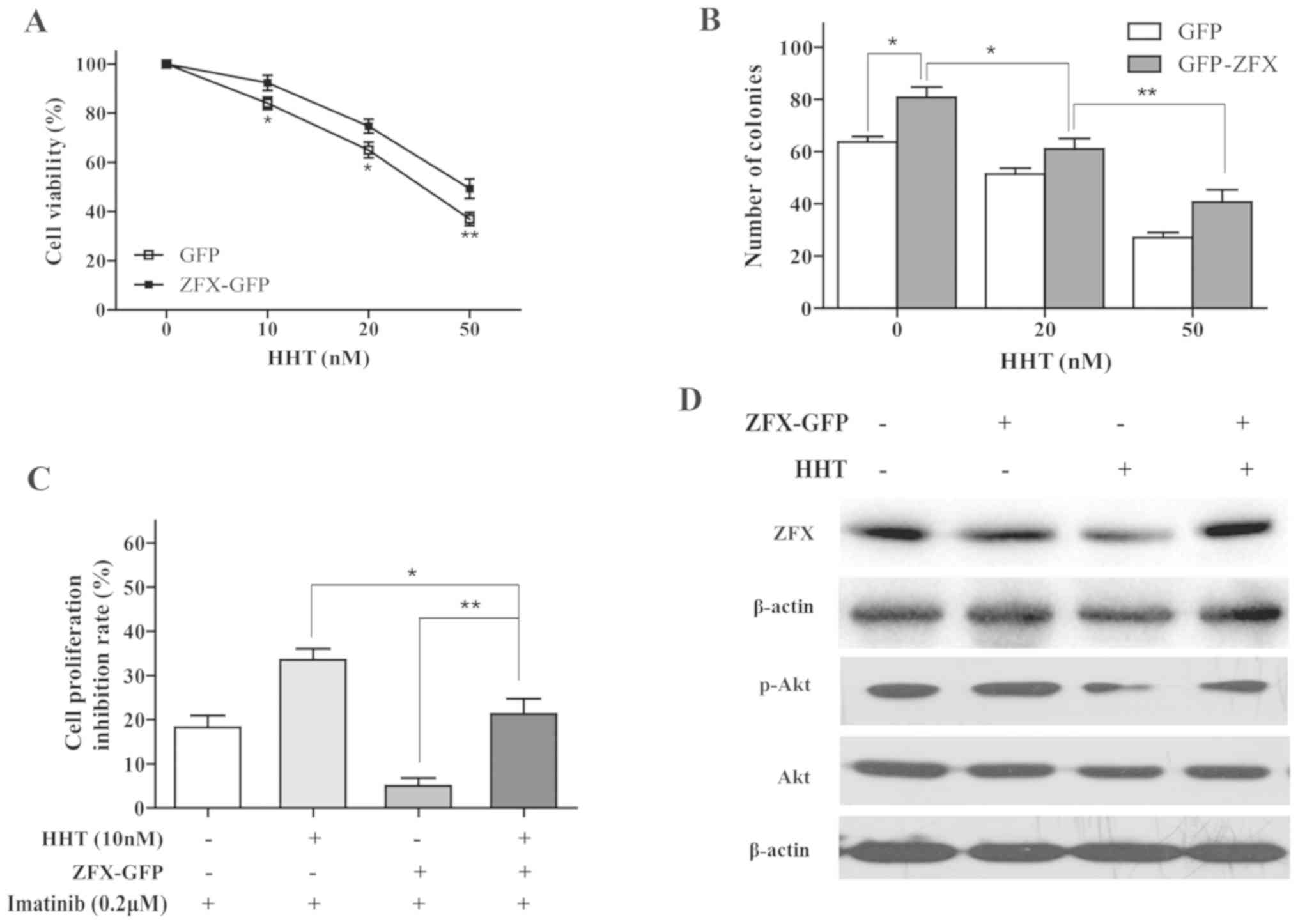|
1
|
Apperley JF: Chronic myeloid leukaemia.
Lancet. 385:1447–1459. 2015. View Article : Google Scholar : PubMed/NCBI
|
|
2
|
Ren R: Mechanisms of BCR-ABL in the
pathogenesis of chronic myelogenous leukaemia. Nat Rev Cancer.
5:172–183. 2005. View
Article : Google Scholar : PubMed/NCBI
|
|
3
|
Steelman LS, Pohnert SC, Shelton JG,
Franklin RA, Bertrand FE and McCubrey JA: JAK/STAT, Raf/MEK/ERK,
PI3K/Akt and BCR-ABL in cell cycle progression and leukemogenesis.
Leukemia. 18:189–218. 2004. View Article : Google Scholar : PubMed/NCBI
|
|
4
|
Druker BJ, Talpaz M, Resta DJ, Peng B,
Buchdunger E, Ford JM, Lydon NB, Kantarjian H, Capdeville R,
Ohno-Jones S and Sawyers CL: Efficacy and safety of a specific
inhibitor of the BCR-ABL tyrosine kinase in chronic myeloid
leukemia. N Engl J Med. 344:1031–1037. 2001. View Article : Google Scholar : PubMed/NCBI
|
|
5
|
Kantarjian HM, Cortes JE, O'Brien S, Giles
F, Garcia-Manero G, Faderl S, Thomas D, Jeha S, Rios MB, Letvak L,
et al: Imatinib mesylate therapy in newly diagnosed patients with
Philadelphia chromosome-positive chronic myelogenous leukemia: High
incidence of early complete and major cytogenetic responses. Blood.
101:97–100. 2003. View Article : Google Scholar : PubMed/NCBI
|
|
6
|
Hochhaus A, Kreil S, Corbin AS, La Rosée
P, Müller MC, Lahaye T, Hanfstein B, Schoch C, Cross NC, Berger U,
et al: Molecular and chromosomal mechanisms of resistance to
imatinib (STI571) therapy. Leukemia. 16:2190–2196. 2002. View Article : Google Scholar : PubMed/NCBI
|
|
7
|
Jabbour EJ, Cortes JE and Kantarjian HM:
Resistance to tyrosine kinase inhibition therapy for chronic
myelogenous leukemia: A clinical perspective and emerging treatment
options. Clin Lymphoma Myeloma Leuk. 13:515–529. 2013. View Article : Google Scholar : PubMed/NCBI
|
|
8
|
Binato R, Mencalha A, Pizzatti L, Scholl
V, Zalcberg I and Abdelhay E: RUNX1T1 is overexpressed in imatinib
mesylate-resistant cells. Mol Med Rep. 2:657–661. 2009. View Article : Google Scholar : PubMed/NCBI
|
|
9
|
Powell RG, Weisleder D and Smith CR Jr:
Antitumor alkaloids for Cephalataxus harringtonia: Structure and
activity. J Pharm Sci. 61:1227–1230. 1972. View Article : Google Scholar : PubMed/NCBI
|
|
10
|
Lü S and Wang J: Homoharringtonine and
omacetaxine for myeloid hematological malignancies. J Hematol
Oncol. 7:22014. View Article : Google Scholar : PubMed/NCBI
|
|
11
|
Kantarjian HM, Talpaz M, Smith TL, Cortes
J, Giles FJ, Rios MB, Mallard S, Gajewski J, Murgo A, Cheson B and
O'Brien S: Homoharringtonine and low-dose cytarabine in the
management of late chronic-phase chronic myelogenous leukemia. J
Clin Oncol. 18:3513–3521. 2000. View Article : Google Scholar : PubMed/NCBI
|
|
12
|
Legros L, Hayette S, Nicolini FE, Raynaud
S, Chabane K, Magaud JP, Cassuto JP and Michallet M: BCR-ABL(T315I)
transcript disappearance in an imatinib-resistant CML patient
treated with homoharringtonine: A new therapeutic challenge.
Leukemia. 21:2204–2206. 2007. View Article : Google Scholar : PubMed/NCBI
|
|
13
|
Wang L, You LS, Ni WM, Ma QL, Tong Y, Mao
LP, Qian JJ and Jin J: β-Catenin and AKT are promising targets for
combination therapy in acute myeloid leukemia. Leuk Res.
37:1329–1340. 2013. View Article : Google Scholar : PubMed/NCBI
|
|
14
|
Dong Y, Gao X, Zhao Y, Wei M, Xu L, Yang G
and Liu L: Semi-random mutagenesis profile of BCR-ABL during
imatinib resistance acquirement in K562 cells. Mol Med Rep.
16:9409–9414. 2017. View Article : Google Scholar : PubMed/NCBI
|
|
15
|
Fresno M, Jiménez A and Vázquez D:
Inhibition of translation in eukaryotic systems by harringtonine.
Eur J Biochem. 72:323–330. 1977. View Article : Google Scholar : PubMed/NCBI
|
|
16
|
Tipping AJ, Mahon FX, Zafirides G, Lagarde
V, Goldman JM and Melo JV: Drug responses of imatinib
mesylate-resistant cells: Synergism of imatinib with other
chemotherapeutic drugs. Leukemia. 16:2349–2357. 2002. View Article : Google Scholar : PubMed/NCBI
|
|
17
|
Galan-Caridad JM, Harel S, Arenzana TL,
Hou ZE, Doetsch FK, Mirny LA and Reizis B: Zfx controls the
self-renewal of embryonic and hematopoietic stem cells. Cell.
129:345–357. 2007. View Article : Google Scholar : PubMed/NCBI
|
|
18
|
Harel S, Tu EY, Weisberg S, Esquilin M,
Chambers SM, Liu B, Carson CT, Studer L, Reizis B and Tomishima MJ:
ZFX controls the self-renewal of human embryonic stem cells. PLoS
One. 7:e423022012. View Article : Google Scholar : PubMed/NCBI
|
|
19
|
Jiang M, Xu S, Yue W, Zhao X, Zhang L,
Zhang C and Wang Y: The role of ZFX in non-small cell lung cancer
development. Oncol Res. 20:171–178. 2012. View Article : Google Scholar : PubMed/NCBI
|
|
20
|
Wu S, Lao XY, Sun TT, Ren LL, Kong X, Wang
JL, Wang YC, Du W, Yu YN, Weng YR, et al: Knockdown of ZFX inhibits
gastric cancer cell growth in vitro and in vivo via downregulating
the ERK-MAPK pathway. Cancer Lett. 337:293–300. 2013. View Article : Google Scholar : PubMed/NCBI
|
|
21
|
Zhu Z, Li K, Xu D, Liu Y, Tang H, Xie Q,
Xie L, Liu J, Wang H, Gong Y, et al: ZFX regulates glioma cell
proliferation and survival in vitro and in vivo. J Neurooncol.
112:17–25. 2013. View Article : Google Scholar : PubMed/NCBI
|
|
22
|
Yang H, Lu Y, Zheng Y, Yu X, Xia X, He X,
Feng W, Xing L and Ling Z: shRNA-mediated silencing of ZFX
attenuated the proliferation of breast cancer cells. Cancer
Chemother Pharmacol. 73:569–576. 2014. View Article : Google Scholar : PubMed/NCBI
|
|
23
|
Weisberg SP, Smith-Raska MR, Esquilin JM,
Zhang J, Arenzana TL, Lau CM, Churchill M, Pan H, Klinakis A, Dixon
JE, et al: ZFX controls propagation and prevents differentiation of
acute T-lymphoblastic and myeloid leukemia. Cell Rep. 6:528–540.
2014. View Article : Google Scholar : PubMed/NCBI
|
|
24
|
Zhang S, Shu R, Yue M and Zhang S: Effect
of over-expression of Zinc-finger protein (ZFX) on self-renewal and
drug-resistance of hepatocellular carcinoma. Med Sci Monit.
22:3025–3034. 2016. View Article : Google Scholar : PubMed/NCBI
|
|
25
|
Lai KP, Chen J, He M, Ching AK, Lau C, Lai
PB, To KF and Wong N: Overexpression of ZFX confers self-renewal
and chemoresistance properties in hepatocellular carcinoma. Int J
Cancer. 135:1790–1799. 2014. View Article : Google Scholar : PubMed/NCBI
|
|
26
|
Wu J, Wei B, Wang Q, Ding Y, Deng Z, Lu X
and Li Y: ZFX facilitates cell proliferation and imatinib
resistance in chronic myeloid leukemia cells. Cell Biochem Biophys.
74:277–283. 2016. View Article : Google Scholar : PubMed/NCBI
|
|
27
|
Yang J, Ikezoe T, Nishioka C, Udaka K and
Yokoyama A: Bcr-Abl activates AURKA and AURKB in chronic myeloid
leukemia cells via AKT signaling. Int J Cancer. 134:1183–1194.
2014. View Article : Google Scholar : PubMed/NCBI
|
|
28
|
Livak KJ and Schmittgen TD: Analysis of
relative gene expression data using real-time quantitative PCR and
the 2(-Delta Delta C(T)) method. Methods. 25:402–408. 2001.
View Article : Google Scholar : PubMed/NCBI
|
|
29
|
Desplat V, Lagarde V, Belloc F, Chollet C,
Leguay T, Pasquet JM, Praloran V and Mahon FX: Rapid detection of
phosphotyrosine proteins by flow cytometric analysis in
Bcr-Abl-positive cells. Cytometry A. 62:35–45. 2004. View Article : Google Scholar : PubMed/NCBI
|
|
30
|
La Rosée P, Holm-Eriksen S, Konig H,
Härtel N, Ernst T, Debatin J, Mueller MC, Erben P, Binckebanck A,
Wunderle L, et al: Phospho-CRKL monitoring for the assessment of
BCR-ABL activity in imatinib-resistant chronic myeloid leukemia or
Ph+ acute lymphoblastic leukemia patients treated with nilotinib.
Haematologica. 93:765–769. 2008. View Article : Google Scholar : PubMed/NCBI
|
|
31
|
Burchert A, Wang Y, Cai D, von Bubnoff N,
Paschka P, Müller-Brüsselbach S, Ottmann OG, Duyster J, Hochhaus A
and Neubauer A: Compensatory PI3-kinase/Akt/mTor activation
regulates imatinib resistance development. Leukemia. 19:1774–1782.
2005. View Article : Google Scholar : PubMed/NCBI
|
|
32
|
Visani G and Isidori A: Resistant chronic
myeloid leukemia beyond tyrosine-kinase inhibitor therapy: Which
role for omacetaxine. Expert Opin Pharmacother. 15:1–3. 2014.
View Article : Google Scholar : PubMed/NCBI
|
|
33
|
Cortes J, Lipton JH, Rea D, Digumarti R,
Chuah C, Nanda N, Benichou AC, Craig AR, Michallet M, Nicolini FE,
et al: Phase 2 study of subcutaneous omacetaxine mepesuccinate
after TKI failure in patients with chronic-phase CML with T315I
mutation. Blood. 120:2573–2580. 2012. View Article : Google Scholar : PubMed/NCBI
|
|
34
|
Wu JJ, Ding YH, Deng ZK, Shi YY, Lu XY and
Li YF: Effect of homoharringtonine combined with Imatinib on the
K562/G01 cells and its mechanism. Zhongguo Shi Yan Xue Ye Xue Za
Zhi. 25:80–84. 2017.(In Chinese). PubMed/NCBI
|
|
35
|
Tong H, Ren Y, Zhang F and Jin J:
Homoharringtonine affects the JAK2-STAT5 signal pathway through
alteration of protein tyrosine kinase phosphorylation in acute
myeloid leukemia cells. Eur J Haematol. 81:259–266. 2008.
View Article : Google Scholar : PubMed/NCBI
|
|
36
|
Hamilton A, Alhashimi F, Myssina S,
Jorgensen HG and Holyoake TL: Optimization of methods for the
detection of BCR-ABL activity in Philadelphia-positive cells. Exp
Hematol. 37:395–401. 2009. View Article : Google Scholar : PubMed/NCBI
|
|
37
|
Chen Y, Hu Y, Michaels S, Segal D, Brown D
and Li S: Inhibitory effects of omacetaxine on leukemic stem cells
and BCR-ABL-induced chronic myeloid leukemia and acute
lymphoblastic leukemia in mice. Leukemia. 23:1446–1454. 2009.
View Article : Google Scholar : PubMed/NCBI
|
|
38
|
Meng H, Yang C, Jin J, Zhou Y and Qian W:
Homoharringtonine inhibits the AKT pathway and induces in vitro and
in vivo cytotoxicity in human multiple myeloma cells. Leuk
Lymphoma. 49:1954–1962. 2008. View Article : Google Scholar : PubMed/NCBI
|
|
39
|
Jiang H, Zhang L, Liu J, Chen Z, Na R,
Ding G, Zhang H and Ding Q: Knockdown of zinc finger protein
X-linked inhibits prostate cancer cell proliferation and induces
apoptosis by activating caspase-3 and caspase-9. Cancer Gene Ther.
19:684–689. 2012. View Article : Google Scholar : PubMed/NCBI
|
|
40
|
Li K, Zhu ZC, Liu YJ, Liu JW, Wang HT,
Xiong ZQ, Shen X, Hu ZL and Zheng J: ZFX knockdown inhibits growth
and migration of non-small cell lung carcinoma cell line H1299. Int
J Clin Exp Pathol. 6:2460–2467. 2013.PubMed/NCBI
|
|
41
|
Fang Q, Fu WH, Yang J, Li X, Zhou ZS, Chen
ZW and Pan JH: Knockdown of ZFX suppresses renal carcinoma cell
growth and induces apoptosis. Cancer Genet. 207:461–466. 2014.
View Article : Google Scholar : PubMed/NCBI
|














